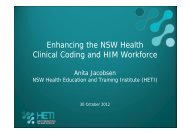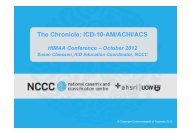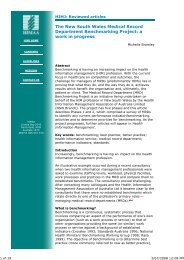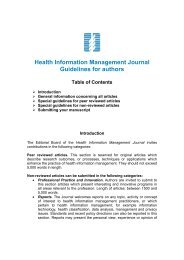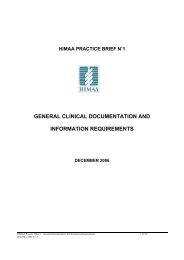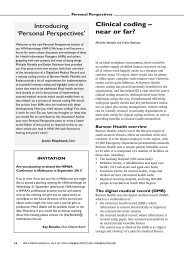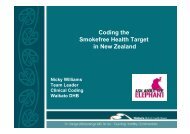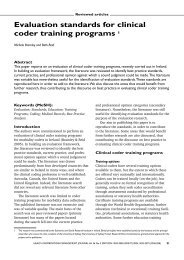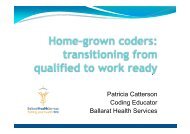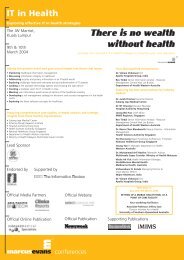Organisational factors affecting the quality of hospital clinical coding
Organisational factors affecting the quality of hospital clinical coding
Organisational factors affecting the quality of hospital clinical coding
Create successful ePaper yourself
Turn your PDF publications into a flip-book with our unique Google optimized e-Paper software.
Reviewed articles<br />
<strong>Organisational</strong> <strong>factors</strong> <strong>affecting</strong> <strong>the</strong><br />
<strong>quality</strong> <strong>of</strong> <strong>hospital</strong> <strong>clinical</strong> <strong>coding</strong><br />
Suong Santos, Gregory Murphy, Kathryn Baxter and Kerin M Robinson<br />
Abstract<br />
The infl uence <strong>of</strong> organisational <strong>factors</strong> on <strong>the</strong> <strong>quality</strong> <strong>of</strong> <strong>hospital</strong> <strong>coding</strong> using <strong>the</strong> International<br />
Statistical Classifi cation <strong>of</strong> Diseases and Health Related Problems, 10 th Revision, Australian Modifi cation<br />
(ICD-10-AM) was investigated using a mixed quantitative-qualitative approach. The organisational<br />
variables studied were: <strong>hospital</strong> specialty; geographical locality; structural characteristics <strong>of</strong> <strong>the</strong> <strong>coding</strong><br />
unit; education, training and resource supports for Clinical Coders; and <strong>quality</strong> control mechanisms.<br />
Baseline data on <strong>the</strong> <strong>hospital</strong>s’ <strong>coding</strong> <strong>quality</strong>, measured by <strong>the</strong> Performance Indicators for Coding<br />
Quality tool, were used as an independent index measure. No differences were found in error rates<br />
between rural and metropolitan <strong>hospital</strong>s, or general and specialist <strong>hospital</strong>s. Clinical Coder allocation<br />
to ‘general’ ra<strong>the</strong>r than ‘specialist’ unit <strong>coding</strong> resulted in fewer errors. Coding Managers reported that<br />
<strong>coding</strong> <strong>quality</strong> can be improved by: Coders engaging in a variety <strong>of</strong> role behaviours; improved Coder<br />
career opportunities; higher staffi ng levels; reduced throughput; fewer time constraints on <strong>coding</strong><br />
outputs and associated work; and increased Coder interactions with medical staff.<br />
Key Words (MeSH):<br />
Information Management; Medical Records Department, Hospital; International Classification <strong>of</strong> Diseases;<br />
Clinical Coding; Hospital Records; Health Information Managers<br />
Introduction<br />
Clinical <strong>coding</strong> errors impede <strong>the</strong> efficient<br />
operation and financial management <strong>of</strong> <strong>hospital</strong>s<br />
and potentially lead to inaccurate state and<br />
national statistics on <strong>hospital</strong> morbidity. The foci<br />
<strong>of</strong> this research were selected organisational<br />
<strong>factors</strong> that might adversely affect <strong>the</strong> <strong>quality</strong> <strong>of</strong><br />
Clinical Coders’ <strong>coding</strong> work and its outcomes.<br />
The relationship between error rates (<strong>clinical</strong><br />
and o<strong>the</strong>r errors) in <strong>hospital</strong>s and <strong>hospital</strong><br />
characteristics is well-established; for example,<br />
Ber<strong>the</strong>lsen (2000) found that teaching <strong>hospital</strong>s<br />
and large <strong>hospital</strong>s had higher error rates than<br />
smaller <strong>hospital</strong>s. In a review <strong>of</strong> organisational<br />
<strong>factors</strong> and <strong>quality</strong>, Flood (1994) reported that<br />
numerous studies have shown strong evidence<br />
that <strong>the</strong> greater <strong>the</strong> volume <strong>of</strong> similar cases<br />
treated (specialisation), <strong>the</strong> better <strong>the</strong> outcomes:<br />
efficiencies can be introduced and staff can<br />
become more practiced in managing certain casetypes.<br />
The literature on <strong>clinical</strong> <strong>coding</strong> error rates<br />
and organisational <strong>factors</strong> is comparatively<br />
sparse. Green and Benjamin (in Murphy-Muth<br />
1987), in <strong>the</strong>ir 1984 study <strong>of</strong> Illinois, United<br />
States <strong>of</strong> America (USA) <strong>hospital</strong>s, identified<br />
patterns and combinations <strong>of</strong> <strong>factors</strong> that affect<br />
<strong>coding</strong> <strong>quality</strong>; <strong>the</strong>y found improved <strong>coding</strong><br />
agreement in <strong>the</strong> majority <strong>of</strong> <strong>hospital</strong>s that<br />
employed credentialled Coders, utilised feedback<br />
as a data <strong>quality</strong> method and <strong>of</strong>fered <strong>coding</strong> staff<br />
continuing education opportunities; however,<br />
statistical tests to identify if <strong>the</strong>se <strong>factors</strong> affected<br />
data <strong>quality</strong> were inconclusive.<br />
Wendler and Slovensky (1987), also in <strong>the</strong><br />
USA, found that increased staff allocations<br />
resulted in a decrease in <strong>coding</strong> error rates from<br />
an average <strong>of</strong> 7.1% to 2.7%. Oncology <strong>coding</strong><br />
error rates were lower in rural areas than in<br />
metropolitan areas, and in newly merged organisations<br />
(Lorence, Spink & Jameson 2002). In a<br />
more recent American study, Lorence and Ibrahim<br />
HEALTH INFORMATION MANAGEMENT JOURNAL Vol 37 No 1 2008 ISSN 1833-3583 (PRINT) ISSN 1833-3575 (ONLINE) 25
Reviewed articles<br />
(2003) measured <strong>the</strong> consistency <strong>of</strong> coded data<br />
through Health Information Managers’ (HIM)<br />
reports <strong>of</strong> overall <strong>coding</strong> error levels in patients’<br />
records. This study suffered from <strong>the</strong> limitation<br />
<strong>of</strong> using respondents’ perceptions <strong>of</strong> error<br />
rates; however, <strong>the</strong> findings included significant<br />
variation in <strong>the</strong> ‘accuracy <strong>of</strong> <strong>coding</strong> practice and<br />
associated data validity across key demographic<br />
and organisational variables’ (Lorence & Ibrahim<br />
2003: 29).<br />
A New South Wales study compared <strong>the</strong><br />
<strong>quality</strong> <strong>of</strong> procedure <strong>coding</strong> by operating <strong>the</strong>atre<br />
staff with that <strong>of</strong> Clinical Coders from <strong>the</strong> Health<br />
Information Service; this revealed a <strong>the</strong>atre staff<br />
error rate <strong>of</strong> 86% compared with a Clinical Coder<br />
error rate <strong>of</strong> 18%, and indicated a direct correlation<br />
between <strong>coding</strong> error rates and different<br />
organisational environments (Callen et al. 1998).<br />
Factors reported to contribute to <strong>the</strong> high level<br />
<strong>of</strong> <strong>the</strong>atre <strong>coding</strong> error rates were: <strong>the</strong> lack <strong>of</strong><br />
formal training in <strong>coding</strong>; old or inadequate<br />
tools available; lack <strong>of</strong> networking with o<strong>the</strong>r<br />
coders and with Australia’s National Centre for<br />
Classification in Health (NCCH) 1 ; and lack <strong>of</strong><br />
<strong>the</strong>atre <strong>coding</strong> audits (Callen et al. 1998). The<br />
authors emphasised <strong>the</strong> importance <strong>of</strong> coder<br />
education, identified as an organisational factor;<br />
<strong>the</strong>y also suggested that addressing <strong>factors</strong> that<br />
vary between <strong>the</strong>se environments may lead to<br />
improvement in <strong>coding</strong> <strong>quality</strong>.<br />
In <strong>the</strong> Australian Coder Workforce Study<br />
(ACWS), a nation-wide survey <strong>of</strong> <strong>hospital</strong> Clinical<br />
Coders, a large proportion <strong>of</strong> <strong>the</strong> respondents<br />
agreed on several organisational <strong>factors</strong> <strong>affecting</strong><br />
<strong>the</strong> accuracy, completeness, and timeliness <strong>of</strong><br />
<strong>coding</strong>, including: a lack <strong>of</strong> continuing coder<br />
education; distractions caused by <strong>the</strong> work environment;<br />
and having to perform multiple tasks<br />
(McKenzie & Walker 2003). In contrast to Green<br />
and Benjamin’s Illinois study, <strong>the</strong> ACWS methodology<br />
used a larger sample size and achieved<br />
a high response rate, <strong>the</strong>reby enhancing <strong>the</strong><br />
validity <strong>of</strong> <strong>the</strong> findings; however, a limitation was<br />
1 The National Centre for Classifi cation in Health (NCCH) is an expert centre<br />
in health classifi cation <strong>the</strong>ory and <strong>coding</strong> systems. It has close links with <strong>the</strong><br />
Australian Department <strong>of</strong> Human Services, <strong>the</strong> Australian Bureau <strong>of</strong> Statistics<br />
and <strong>the</strong> Australian Institute <strong>of</strong> Health and Welfare. It is charged with <strong>the</strong><br />
development and maintenance <strong>of</strong> <strong>the</strong> Australian version <strong>of</strong> <strong>the</strong> World Health<br />
Organization’s International Classifi cation <strong>of</strong> Diseases.<br />
that respondents’ perceptions were used without<br />
objective, substantiating measures.<br />
<strong>Organisational</strong> <strong>factors</strong> that <strong>the</strong> Australian<br />
NCCH believes may impact upon <strong>coding</strong> <strong>quality</strong><br />
include: communication with clinicians; ongoing<br />
coder education; review <strong>of</strong> <strong>the</strong> <strong>coding</strong> and<br />
documentation process by peers or a superior;<br />
coder environment and workload; availability<br />
<strong>of</strong> reference materials to guide code allocation;<br />
ongoing coder education; and resource<br />
support from management (Williamson et al.<br />
1999). These appear to be founded on results<br />
from Australian and American studies which<br />
recognised <strong>the</strong> importance <strong>of</strong> ongoing education<br />
for <strong>quality</strong> <strong>coding</strong>, such as induction programs<br />
for new coders (Groom 2000; Hassan, Meara &<br />
Bhowmick 1995; Osborn 1999; Stevens, Unwin<br />
& Codde 1998, Thompson & Koch 1999), and<br />
to reflect findings from o<strong>the</strong>r studies (Demlo<br />
& Campbell 1981; Green & Benjamin 1986;<br />
Mehanni et al. 1995). Several authors have<br />
fur<strong>the</strong>r advocated <strong>the</strong> use <strong>of</strong> credentialled<br />
staff, in-service education, initial orientation<br />
and training, and appropriate communication<br />
and interaction between coders and healthcare<br />
pr<strong>of</strong>essionals (Fletcher 2002; Mears et al. 2002;<br />
Waterstraat 1990).<br />
The American Health Information<br />
Management Association’s (AHIMA) Coding<br />
Practice Team suggests that ‘current <strong>coding</strong><br />
manuals must be readily accessible …, dialogue<br />
between <strong>coding</strong> pr<strong>of</strong>essionals and clinicians<br />
is encouraged… and … <strong>coding</strong> should be<br />
performed by credentialled HIM pr<strong>of</strong>essionals’<br />
(AHIMA 2001; Prophet 2001). Fletcher (2002)<br />
recommended <strong>the</strong> use <strong>of</strong> appropriate resources<br />
including <strong>coding</strong> books, guidelines, and electronic<br />
encoder s<strong>of</strong>tware.<br />
Current practice suggests that a number<br />
<strong>of</strong> <strong>the</strong>se resources and practices are in use in<br />
Australian Health Information Services (Groom<br />
2000). We determined that it was timely to<br />
investigate <strong>the</strong> contribution <strong>of</strong> organisational<br />
structures and processes to <strong>the</strong> production <strong>of</strong> high<br />
<strong>quality</strong> coded health data, and to identify <strong>the</strong><br />
most successful <strong>of</strong> <strong>the</strong>se.<br />
26 HEALTH INFORMATION MANAGEMENT JOURNAL Vol 37 No 1 2008 ISSN 1833-3583 (PRINT) ISSN 1833-3575 (ONLINE)
Reviewed articles<br />
Areas <strong>of</strong> study<br />
The research question<br />
Our research addressed <strong>the</strong> following question:<br />
To what extent is a selected group <strong>of</strong> organisational<br />
<strong>factors</strong> <strong>affecting</strong> <strong>hospital</strong> <strong>coding</strong> <strong>quality</strong>,<br />
as measured by error indicators, using <strong>the</strong><br />
Performance Indicators in Coding Quality (PICQ)<br />
tool (NCCH, 2003). 2<br />
Hypo<strong>the</strong>sis, aim and objectives<br />
Our working hypo<strong>the</strong>sis was that selected organisational<br />
<strong>factors</strong> influence <strong>the</strong> <strong>quality</strong> <strong>of</strong> <strong>coding</strong><br />
in participating <strong>hospital</strong>s in <strong>the</strong> state <strong>of</strong> Victoria,<br />
Australia. The aim <strong>of</strong> our research was to investigate<br />
<strong>the</strong> extent to which a group <strong>of</strong> organisational<br />
<strong>factors</strong> affects <strong>the</strong> <strong>quality</strong> <strong>of</strong> ICD-10-AM 3 <strong>coding</strong><br />
<strong>of</strong> admitted episodes in selected <strong>hospital</strong>s in<br />
Victoria, when <strong>the</strong> <strong>coding</strong> <strong>quality</strong> is measured by<br />
<strong>the</strong> rate <strong>of</strong> error indicators detected using PICQ.<br />
The objectives <strong>of</strong> <strong>the</strong> study were to determine<br />
whe<strong>the</strong>r <strong>the</strong> following <strong>factors</strong> influence <strong>the</strong><br />
<strong>quality</strong> <strong>of</strong> <strong>clinical</strong> <strong>coding</strong>:<br />
•<br />
•<br />
•<br />
•<br />
•<br />
<strong>hospital</strong> specialty<br />
geographical locality <strong>of</strong> <strong>the</strong> <strong>hospital</strong><br />
structural characteristics <strong>of</strong> <strong>the</strong> Coding Unit<br />
support provided to <strong>the</strong> Clinical Coders by way<br />
<strong>of</strong> education, training and resources<br />
<strong>coding</strong> <strong>quality</strong> control mechanisms.<br />
Method<br />
Definitions<br />
For <strong>the</strong> purposes <strong>of</strong> <strong>the</strong> study, <strong>the</strong> term ‘<strong>coding</strong>’<br />
was used to include <strong>the</strong> following activities:<br />
abstracting terms from <strong>the</strong> health information in<br />
<strong>the</strong> medical records; allocating ICD-10-AM codes;<br />
sequencing <strong>of</strong> codes to identify <strong>the</strong> principal<br />
diagnosis; indexing <strong>of</strong> codes or entering coded<br />
data into a morbidity database; and updating<br />
<strong>the</strong> <strong>coding</strong> books. The term ‘Clinical Coder’ was<br />
considered to be inclusive <strong>of</strong> <strong>the</strong> pr<strong>of</strong>essional<br />
Health Information Managers whose universitydegree<br />
qualification enables <strong>the</strong>m to undertake<br />
2 The PICQ tool was developed by <strong>the</strong> NCCH for use in <strong>hospital</strong><br />
<strong>clinical</strong> <strong>coding</strong>.<br />
3 ICD-10-AM is <strong>the</strong> 10 th edition <strong>of</strong> <strong>the</strong> Australian modification <strong>of</strong> <strong>the</strong><br />
World Health Organization’s International Classification <strong>of</strong> Diseases.<br />
This is used in Australia, New Zealand, and a number <strong>of</strong> o<strong>the</strong>r<br />
countries around <strong>the</strong> globe.<br />
complex <strong>clinical</strong> <strong>coding</strong>, and o<strong>the</strong>rs who work as<br />
Clinical Coders and whose <strong>coding</strong> education is<br />
sub-tertiary or non-university based.<br />
The study participants<br />
A criterion sampling approach was used to<br />
include <strong>hospital</strong>s belonging to an existing benchmarking<br />
group <strong>of</strong> metropolitan <strong>hospital</strong>s, which<br />
establish and compare standards for health<br />
information-related processes, plus additional<br />
specialist and rural <strong>hospital</strong>s (McBurney 1994).<br />
In order to investigate whe<strong>the</strong>r ‘<strong>hospital</strong> specialty’<br />
was a factor influencing <strong>coding</strong> <strong>quality</strong>, all<br />
Victorian public specialist <strong>hospital</strong>s were included<br />
in <strong>the</strong> sample. Four large, public rural <strong>hospital</strong>s<br />
were also recruited to enable exploration <strong>of</strong> <strong>the</strong><br />
study objective pertaining to ‘geographic locality’<br />
as a potential factor influencing <strong>coding</strong> <strong>quality</strong>.<br />
The criteria for selection <strong>of</strong> <strong>the</strong> rural <strong>hospital</strong>s<br />
into <strong>the</strong> sample were <strong>the</strong> highest Weighted Inlier<br />
Equivalent Separation (WIES) targets for <strong>the</strong><br />
most recent (2003-2004) financial year, identified<br />
for <strong>the</strong> different regions within <strong>the</strong> state (where<br />
WIES is an independent measure <strong>of</strong> <strong>the</strong> number<br />
<strong>of</strong> discharges and <strong>the</strong> complexity <strong>of</strong> a <strong>hospital</strong>’s<br />
case mix within <strong>the</strong> state’s casemix-based <strong>hospital</strong><br />
funding system).<br />
Of <strong>the</strong> <strong>hospital</strong>s approached for recruitment<br />
into <strong>the</strong> study, 14 <strong>of</strong> <strong>the</strong> 15 agreed to participate,<br />
yielding a participation rate <strong>of</strong> 93%. The sample<br />
comprised six large, public general <strong>hospital</strong>s with<br />
substantial resource consumption, four specialist<br />
<strong>hospital</strong>s in Melbourne, and four rural <strong>hospital</strong>s.<br />
We assumed that <strong>the</strong> selected <strong>hospital</strong>s would<br />
have multiple coders and a broader casemix than<br />
smaller <strong>hospital</strong>s with fewer discharges.<br />
Study design and procedure<br />
The study data, which collectively described <strong>the</strong><br />
14 <strong>hospital</strong>s’ <strong>coding</strong> performance, were obtained<br />
via a self-administered survey instrument. A<br />
combined quantitative-qualitative approach to<br />
<strong>the</strong> investigation <strong>of</strong> organisational <strong>factors</strong> and<br />
<strong>coding</strong> <strong>quality</strong> was utilised. The ‘mixed-methods’<br />
approach, also known as triangulation, was used<br />
to produce richer and more insightful analyses <strong>of</strong><br />
<strong>the</strong> study data (Denzin 1978; Flick 1992).<br />
Performance Indicators in Coding Quality<br />
(PICQ) is a set <strong>of</strong> indicators that can identify<br />
incorrectly coded records in datasets. PICQ was<br />
HEALTH INFORMATION MANAGEMENT JOURNAL Vol 37 No 1 2008 ISSN 1833-3583 (PRINT) ISSN 1833-3575 (ONLINE) 27
Reviewed articles<br />
developed by <strong>the</strong> NCCH and is based on <strong>the</strong><br />
Australian Coding Standards (ACS) and <strong>the</strong><br />
International Statistical Classification <strong>of</strong> Diseases,<br />
Tenth Revision, Australian Modification (ICD-10-<br />
AM) <strong>coding</strong> conventions. The indicators provide<br />
a standard ‘language’ for describing variation in<br />
coded data, enabling outcomes to be compared<br />
between facilities and over time (Waller & Watts<br />
2002).<br />
Approval to conduct <strong>the</strong> research was given by<br />
<strong>the</strong> La Trobe University Faculty <strong>of</strong> Health Sciences<br />
Human Research Ethics Committee, and consent<br />
was obtained from each participating <strong>hospital</strong> for<br />
access to <strong>the</strong>ir <strong>coding</strong> performance data held by<br />
<strong>the</strong> Victorian state Department <strong>of</strong> Human Services<br />
(DHS). The research comprised two phases, each<br />
incorporating different data collection techniques.<br />
Phase 1: survey.<br />
In Phase 1, study data were collected in a survey<br />
<strong>of</strong> <strong>the</strong> Coding Unit Managers <strong>of</strong> <strong>the</strong> participating<br />
<strong>hospital</strong>s’ Health Information Services (HIS). The<br />
Coding Managers’ contact details were identified<br />
through a Pr<strong>of</strong>essional Practice Program database<br />
in <strong>the</strong> Health Information Management Program<br />
at La Trobe University, and through pr<strong>of</strong>essional<br />
networks. We contacted <strong>the</strong> Coding Managers<br />
initially via email to explain <strong>the</strong> purpose <strong>of</strong> <strong>the</strong><br />
study and obtain preliminary consent.<br />
The survey documents included an instruction<br />
sheet, consent form, terms defined for<br />
<strong>the</strong> purpose <strong>of</strong> <strong>the</strong> study, a three-part survey<br />
instrument designed to assist in improving <strong>the</strong><br />
researchers’ understanding <strong>of</strong> <strong>the</strong> structural<br />
functioning <strong>of</strong> each sample <strong>hospital</strong>’s HIS, and<br />
a reply-paid envelope; <strong>the</strong>se were mailed to <strong>the</strong><br />
participating Coding Managers, for return within<br />
a three-week timeframe. The questionnaire<br />
contained both open and closed questions which<br />
queried <strong>the</strong> structure, specifically <strong>the</strong> physical<br />
arrangement, <strong>of</strong> <strong>the</strong> <strong>coding</strong> unit. The literature<br />
supports <strong>clinical</strong> coders having regular interaction<br />
with <strong>clinical</strong> (medical) staff; <strong>the</strong>refore,<br />
<strong>the</strong> questions were designed also to enable an<br />
analysis <strong>of</strong> current practice in coder-clinician<br />
communication.<br />
Phase 2: interview.<br />
In Phase 2, data were collected in a structured,<br />
follow-up telephone interview with <strong>the</strong> Coding<br />
Manager <strong>of</strong> each <strong>hospital</strong> in <strong>the</strong> sample; <strong>the</strong><br />
responses were recorded and <strong>the</strong>n transcribed<br />
for analysis. The telephone interviews, previously<br />
demonstrated to be an effective, efficient<br />
and economically feasible approach (Fenig et<br />
al.1993), permitted direct communication with<br />
sample members in remote areas, allowed <strong>the</strong><br />
researchers access to Coding Managers with a<br />
demanding workload, and created a sense <strong>of</strong><br />
partial anonymity. Additional information about<br />
<strong>hospital</strong> organisation and processes was elicited,<br />
as well as <strong>the</strong> respondents’ perspectives on organisational<br />
issues impacting upon <strong>coding</strong> <strong>quality</strong><br />
and <strong>the</strong> relative importance <strong>of</strong> particular organisational<br />
structures or events.<br />
Data analysis<br />
PICQ: an index measure <strong>of</strong> <strong>coding</strong> <strong>quality</strong><br />
Following phases 1 and 2, <strong>the</strong> PICQ data were<br />
obtained from <strong>the</strong> Victorian DHS for <strong>the</strong> most<br />
recent financial year. The rate <strong>of</strong> ‘fatal’ indicators<br />
detected through PICQ was used as <strong>the</strong> measure<br />
<strong>of</strong> <strong>coding</strong> <strong>quality</strong>. PICQ categorises coded data<br />
according to degree <strong>of</strong> problem (fatal, warning,<br />
and relative) and type <strong>of</strong> problem (edit, completeness,<br />
redundancy, specificity, and sequencing).<br />
The data provided in this research contained<br />
all numerators and denominators by degree ‘A’<br />
(fatal), by all types <strong>of</strong> problem, for all <strong>hospital</strong>s<br />
in <strong>the</strong> sample. The PICQ data, <strong>the</strong>refore, were<br />
used as an independent index measure <strong>of</strong> <strong>coding</strong><br />
<strong>quality</strong>.<br />
The PICQ data from DHS covered only 10 <strong>of</strong><br />
<strong>the</strong> 12 months requested and this was considered<br />
to be sufficiently representative to conduct <strong>the</strong><br />
research. The data were collected on a <strong>hospital</strong><br />
basis and specific, individual cases were not identified.<br />
The quantitative data<br />
The t test formula was used to test <strong>the</strong> two<br />
principal organisational variables, specifically<br />
<strong>hospital</strong> specialty and geographical locality; <strong>the</strong><br />
o<strong>the</strong>r main statistical test employed was <strong>the</strong><br />
Fisher exact test, used in preference to chi-square<br />
analysis because N was less than 20 (Siegel<br />
1956:115, 110). For most <strong>of</strong> <strong>the</strong> analyses using<br />
<strong>the</strong> Fisher test, <strong>the</strong> set <strong>of</strong> <strong>hospital</strong>s was divided<br />
into two categories: <strong>the</strong> mean PICQ score for all<br />
<strong>hospital</strong>s was calculated and if <strong>the</strong> individual<br />
<strong>hospital</strong>’s score was at or above <strong>the</strong> mean, it<br />
28 HEALTH INFORMATION MANAGEMENT JOURNAL Vol 37 No 1 2008 ISSN 1833-3583 (PRINT) ISSN 1833-3575 (ONLINE)
Reviewed articles<br />
was categorised as ‘PICQ ≥ Average’; a <strong>hospital</strong>’s<br />
score below <strong>the</strong> mean was classified as ‘PICQ <<br />
Average’. Splitting <strong>the</strong> <strong>hospital</strong>s thus enabled<br />
<strong>the</strong> creation <strong>of</strong> a series <strong>of</strong> ‘two by two’ contingency<br />
tables, to which <strong>the</strong> Fisher test could be<br />
applied. (While a large number <strong>of</strong> contingency<br />
tables was created, no adjustments to alpha levels<br />
were made as this was an exploratory study in<br />
a little-researched area). Additionally, Pearson’s<br />
measure <strong>of</strong> correlation was used to determine <strong>the</strong><br />
degree <strong>of</strong> significance <strong>of</strong> <strong>the</strong> observed association<br />
between <strong>the</strong> number <strong>of</strong> staff employed (expressed<br />
in terms <strong>of</strong> equivalent full-time [EFT] staff<br />
members) and error rates (per Lumsden 1971;<br />
Nunnally 1970).<br />
The qualitative data<br />
Patterns <strong>of</strong> relationships between <strong>the</strong> different<br />
<strong>hospital</strong>s were identified through <strong>the</strong>matic<br />
analysis. The qualitative data were coded, <strong>the</strong><br />
categories were identified and relationships<br />
observed, and <strong>the</strong>mes were identified and<br />
explored. An independent assessor participated in<br />
<strong>the</strong> allocation, in order to enhance <strong>the</strong> reliability<br />
<strong>of</strong> categorisation.<br />
The PICQ data<br />
Pivot tables from MS Excel were used to assist <strong>the</strong><br />
extraction <strong>of</strong> PICQ data. These data were linked<br />
to responses obtained from <strong>the</strong> surveys and interviews<br />
to identify <strong>the</strong> existence <strong>of</strong> any correlations<br />
between <strong>quality</strong> variables and organisational<br />
variables. PICQ scores range from 00-100%, with<br />
lower scores indicating higher <strong>quality</strong>. Most scores<br />
for <strong>the</strong> participating <strong>hospital</strong>s ranged from 0-1%.<br />
Results<br />
Characteristics <strong>of</strong> <strong>the</strong> Coding Managers<br />
All respondent Coding Managers were qualified<br />
Health Information Managers responsible for <strong>the</strong><br />
<strong>coding</strong> and casemix functions in <strong>the</strong>ir <strong>hospital</strong>s.<br />
Some held <strong>the</strong> position <strong>of</strong> Manager, Health<br />
Information Services; Table 1 shows <strong>the</strong>ir occupational<br />
titles and pr<strong>of</strong>essional experience. The<br />
respondents’ mean industry experience was 15.46<br />
years, with a standard deviation <strong>of</strong> 11.19 years,<br />
and a sample range <strong>of</strong> 4.5 – 40.0 years. The mean<br />
tenure <strong>of</strong> <strong>the</strong> participants’ current position was<br />
3.99 years, with a standard deviation <strong>of</strong> 2.93<br />
years, and a range <strong>of</strong> 4 months to 10 years.<br />
Table 1: Coding Managers’ titles,<br />
industry experience, and tenure<br />
HOSPITAL INDUSTRY<br />
CODE EXPERIENCE CURRENT OCCUPATION TITLE<br />
YRS<br />
1 4.5 Health Information Manager<br />
2 9.0 Health Information Manager<br />
3 5.5 Coding Co-ordinator<br />
4 6.0 Data Manager - Coding<br />
5 14.0 Manager, Health Information Services<br />
6 15.0 Manager, Health Information Services<br />
7 25.0 Coding & Casemix Education Manager<br />
8 13.0 Coding Manager<br />
9 32.0 Manager Coding & Casemix Service<br />
(HIS)*<br />
10 5.5 Deputy Casemix Co-ordinator<br />
11 5.0 Health Information Manager<br />
12 40.0 Acting Manager,<br />
Health Information Services<br />
13 25.0 Health Information Manager<br />
14 17.0 Manager, Health Information Services<br />
Mean 15.6<br />
SD 11.19<br />
* HIS: Health Information Service<br />
Table 2 shows <strong>the</strong> number <strong>of</strong> EFT Clinical Coders<br />
employed in each participating <strong>hospital</strong> and <strong>the</strong><br />
PICQ scores. The number <strong>of</strong> EFTs reported from<br />
<strong>the</strong> surveys was adjusted in line with <strong>the</strong> number<br />
<strong>of</strong> annual separations 4 (per 100,000) per <strong>hospital</strong><br />
(data obtained from <strong>the</strong> Victorian DHS). It can be<br />
observed that <strong>the</strong> number <strong>of</strong> EFT Clinical Coders<br />
varies between <strong>hospital</strong>s, with a range <strong>of</strong> 0.79 to<br />
2.79 EFT coders per 10,000 separations.<br />
The <strong>hospital</strong>s’ PICQ scores ranged from .036 –<br />
.958%, where lower scores indicate better <strong>quality</strong>.<br />
The PICQ mean was .320% and <strong>the</strong> standard<br />
deviation was .217%.<br />
4 Hospital discharges<br />
HEALTH INFORMATION MANAGEMENT JOURNAL Vol 37 No 1 2008 ISSN 1833-3583 (PRINT) ISSN 1833-3575 (ONLINE) 29
Reviewed articles<br />
Table 2: Hospitals’ PICQ scores,<br />
Clinical Coder complement, and<br />
ratio <strong>of</strong> Coder to (adjusted) separations<br />
EFT* CLINICAL<br />
EFT*<br />
CODERS<br />
HOSPITAL CLINICAL ADJUSTED PER<br />
IDENTIFICATION CODERS 10,000 SEPARATIONS PICQ<br />
%<br />
1 4.00 2.30 .205<br />
2 1.00 0.79 .320<br />
3 6.50 2.30 .958<br />
4 7.10 2.21 .408<br />
5 5.20 1.68 .492<br />
6 6.49 1.76 .299<br />
7 10.11 1.77 .192<br />
8 11.96 1.43 .211<br />
9 12.43 2.15 .036<br />
10 9.00 1.78 .258<br />
11 2.50 1.03 .242<br />
12 7.00 2.79 .303<br />
13 4.90 2.37 .400<br />
14 4.50 1.84 .150<br />
Mean – – .320<br />
* EFT: equivalent full-time<br />
Note. r = .201, p > .05, two-tailed test, df = 12 (Refer Nunnally 1970)<br />
The results <strong>of</strong> <strong>the</strong> t test, when applied to <strong>the</strong><br />
error rate figures between <strong>the</strong> groups <strong>of</strong> <strong>hospital</strong>s<br />
examined, indicated that <strong>the</strong>re were no statistically<br />
significant differences in error rates for: (a)<br />
specialist versus general <strong>hospital</strong>s (t[12] = 2.179,<br />
p < .05, two-tailed test); and (b) metropolitan<br />
versus rural <strong>hospital</strong>s (t[12] = 2.179, p < .05,<br />
two-tailed test).<br />
<strong>Organisational</strong> variable 3: structural<br />
characteristics <strong>of</strong> <strong>the</strong> Coding Unit<br />
Findings from <strong>the</strong> quantitative data<br />
A low positive correlation was found (r=.201)<br />
between <strong>coding</strong> <strong>quality</strong> and <strong>the</strong> number <strong>of</strong><br />
EFT Coders employed; see Table 2. This result<br />
indicates that <strong>the</strong>re is no statistically significant<br />
relationship between a higher density <strong>of</strong> <strong>coding</strong><br />
staff and lower (i.e. ‘better’) PICQ scores.<br />
There was no statistically significant relationship<br />
identified between a <strong>hospital</strong> having a<br />
designated Coding Manager and its PICQ score.<br />
Similarly, <strong>the</strong>re was no statistically significant<br />
relationship between <strong>the</strong> physical location <strong>of</strong><br />
Coders and <strong>the</strong> PICQ <strong>quality</strong> score, nor between<br />
regular (minimum, monthly) Coder-clinician<br />
interaction and (improved) PICQ <strong>quality</strong> score.<br />
Coding Managers reported that <strong>the</strong> main forms<br />
<strong>of</strong> Coder interaction with <strong>clinical</strong> staff to discuss<br />
<strong>coding</strong> issues were: unit meetings, <strong>clinical</strong> <strong>coding</strong><br />
meetings, ‘query’ forms, <strong>clinical</strong> partnership, and<br />
o<strong>the</strong>r meetings as required. Coders in <strong>hospital</strong>s<br />
with PICQ scores above average (i.e. scores<br />
indicating poorer <strong>quality</strong>) demonstrated only<br />
irregular, ‘as-needs’ interaction with clinicians.<br />
There was no statistically significant relationship<br />
identified between a <strong>hospital</strong> providing<br />
feedback to <strong>clinical</strong> staff about <strong>the</strong> adequacy <strong>of</strong><br />
<strong>clinical</strong> documentation, and PICQ <strong>quality</strong>. Coders<br />
(86%) provided feedback to <strong>clinical</strong> staff about<br />
<strong>the</strong> adequacy <strong>of</strong> <strong>clinical</strong> documentation, primarily<br />
via <strong>the</strong> following means: <strong>clinical</strong> unit meetings on<br />
documentation deficiencies and effects on DRG<br />
grouping; one-to-one basis as required; documentation<br />
requirements outlined to new doctors at<br />
orientation; casemix/<strong>coding</strong> education; discussion<br />
with unit manager; verbal comments; ‘Casemix<br />
and Documentation’ information sessions with<br />
medical staff; and ‘deficiency’ letters.<br />
In contrast to <strong>the</strong> above findings, a reliable<br />
association was found between general ra<strong>the</strong>r<br />
than specialised <strong>coding</strong> and lower (better) PICQ<br />
scores; see Table 3. There was no statistically<br />
significant association between a <strong>hospital</strong>’s PICQ<br />
score and its <strong>coding</strong> staff having o<strong>the</strong>r major<br />
responsibilities (p > .05).<br />
Table 3: Contingency table showing association<br />
between obtained responses to <strong>the</strong> question ‘Are<br />
<strong>the</strong> majority <strong>of</strong> your Coders allocated to specialist<br />
areas or to general <strong>coding</strong> across all units?’ with<br />
PICQ scores <strong>of</strong> below-average compared with those<br />
above average<br />
GENERAL SPECIALIST<br />
CODING CODING TOTAL<br />
PICQ < Average 9 (100%) 0 ( 0%) 9<br />
PICQ ≥ Average 2 ( 40%) 3 (60%) 5<br />
11 3 14<br />
30 HEALTH INFORMATION MANAGEMENT JOURNAL Vol 37 No 1 2008 ISSN 1833-3583 (PRINT) ISSN 1833-3575 (ONLINE)
Reviewed articles<br />
Findings from <strong>the</strong> qualitative data<br />
In contrast to <strong>the</strong> findings from <strong>the</strong> quantitative<br />
data, all participants indicated during <strong>the</strong><br />
interview that <strong>the</strong> way in which <strong>the</strong> Coding<br />
Unit is organised and structured would have an<br />
impact on <strong>coding</strong> <strong>quality</strong>. Yet few common <strong>the</strong>mes<br />
emerged to differentiate between <strong>hospital</strong>s<br />
with PICQ scores below average and those with<br />
above average scores. Recurring <strong>the</strong>mes emerged<br />
concerning structural features reported as facilitating<br />
better <strong>coding</strong> <strong>quality</strong>:<br />
• lack <strong>of</strong> proper structure creates barriers to<br />
<strong>quality</strong> <strong>of</strong> <strong>coding</strong><br />
• more accurate <strong>coding</strong> is facilitated by Coders’<br />
easy access to clinicians<br />
• <strong>the</strong> physical setting must be properly<br />
structured to avoid work disruption<br />
• <strong>coding</strong> Managers employed at large <strong>hospital</strong>s<br />
need to act as liaisons<br />
• coders should be located close to <strong>the</strong>ir Coding<br />
Manager.<br />
There was a mixture <strong>of</strong> opinion regarding<br />
Clinical Coders’ workstation organisation. Many<br />
respondents believed that open-plan <strong>of</strong>fices can<br />
be noisy and engender disruptions, but that<br />
physical isolation can produce a perception <strong>of</strong> a<br />
lower level <strong>of</strong> support <strong>the</strong>reby reducing <strong>coding</strong><br />
<strong>quality</strong>, whereas o<strong>the</strong>rs believed that co-location<br />
<strong>of</strong> Coders provides an opportunity for discussion<br />
<strong>of</strong> ideas and issues. Never<strong>the</strong>less, <strong>the</strong>re was a<br />
unanimous view in favour <strong>of</strong> Coders being located<br />
within <strong>the</strong> HIS for easier access to medical<br />
records and that <strong>the</strong> structure <strong>of</strong> <strong>the</strong> Coding Unit<br />
must ‘support’ Coders through provision <strong>of</strong> a<br />
satisfactory work environment. Generally, though,<br />
<strong>the</strong> patterns <strong>of</strong> <strong>hospital</strong> error rates were not<br />
consistent with <strong>the</strong>se reported views.<br />
<strong>Organisational</strong> variable 4: education, training and<br />
support level<br />
Findings from <strong>the</strong> quantitative data<br />
All Coding Managers indicated that 100% <strong>of</strong> <strong>the</strong>ir<br />
Coders held recognised qualifications in <strong>clinical</strong><br />
<strong>coding</strong>. ‘Two by two’ contingency tables (33 in<br />
all) were created to investigate various elements<br />
<strong>of</strong> continuing education, training and resource<br />
support and <strong>the</strong>ir influence, if any, on <strong>coding</strong><br />
<strong>quality</strong>; none <strong>of</strong> <strong>the</strong>se supports was found to be<br />
reliably associated with improved <strong>coding</strong> <strong>quality</strong>.<br />
However, <strong>the</strong> data did identify two elements with<br />
a tendency (as opposed to a statistical significance)<br />
for an association with superior <strong>quality</strong>:<br />
(a) <strong>hospital</strong>s providing <strong>the</strong>ir Coders with access to<br />
<strong>the</strong> ICD-10-AM browser to help <strong>the</strong>m code; and<br />
(b) <strong>hospital</strong>s using HIS Coding staff meetings as<br />
educational opportunities.<br />
No statistically significant association was<br />
found between improved PICQ <strong>quality</strong> scores and<br />
<strong>the</strong> existence <strong>of</strong> in-house programs to support<br />
new Coders (i.e. induction by units, review<br />
<strong>of</strong> <strong>the</strong> new Coder’s work with <strong>coding</strong> peers,<br />
in-depth training by <strong>the</strong> Coding Manager, all<br />
<strong>coding</strong> checked and feedback provided, extensive<br />
training period covering all specialties, induction<br />
and/or orientation and/or graduate program,<br />
gradual increase in <strong>coding</strong> complexity level)<br />
or with financial support for Coders to attend<br />
courses, or <strong>the</strong> provision <strong>of</strong> ‘o<strong>the</strong>r incidental costs’<br />
associated with pr<strong>of</strong>essional support.<br />
Findings from <strong>the</strong> qualitative data<br />
Despite <strong>the</strong> non-significant results from <strong>the</strong><br />
quantitative data, all 14 participants stated<br />
emphatically in <strong>the</strong> interviews that <strong>the</strong>y considered<br />
education, training and resource support<br />
levels to have an effect on <strong>coding</strong> <strong>quality</strong>. The<br />
majority <strong>of</strong> respondents believed that continuous,<br />
up-to-date education was important and reinforced<br />
<strong>the</strong>ir views by expressing opinions such as<br />
<strong>the</strong> following:<br />
• ‘It is imperative to have a good training<br />
structure’.<br />
• ‘There is a reduction in <strong>quality</strong> when <strong>the</strong>re is<br />
no education’.<br />
• ‘An increase in education produces better<br />
Coders’.<br />
• ‘Inadequate external training programs result<br />
in inconsistency in <strong>coding</strong>’.<br />
• ‘Education should be in place when <strong>the</strong>re are<br />
revisions to ICD-10-AM <strong>coding</strong> books’.<br />
• ‘Quality improves when <strong>the</strong>re are <strong>coding</strong><br />
education programs involving clinicians.’<br />
Fur<strong>the</strong>rmore, <strong>the</strong> Coding Managers suggested<br />
that while <strong>the</strong>y expected new graduates to have a<br />
basic understanding <strong>of</strong> <strong>coding</strong>, <strong>the</strong>re must be an<br />
organisational structure to support <strong>the</strong>m. They<br />
also consistently asserted that greater emphasis<br />
should be placed on <strong>the</strong> adequacy <strong>of</strong> financial<br />
resources, by having adequate funding available<br />
to enable Coders to attend workshops.<br />
HEALTH INFORMATION MANAGEMENT JOURNAL Vol 37 No 1 2008 ISSN 1833-3583 (PRINT) ISSN 1833-3575 (ONLINE) 31
Reviewed articles<br />
<strong>Organisational</strong> variable 5: <strong>quality</strong> control<br />
activities<br />
Findings from <strong>the</strong> quantitative data<br />
All respondents indicated that <strong>the</strong>ir Coders received<br />
individual feedback from internal and external<br />
audits.<br />
No statistically significant relationship was<br />
found between (improved) PICQ <strong>quality</strong> scores<br />
and having somebody employed whose job<br />
description included analysis <strong>of</strong> coded data<br />
<strong>quality</strong>. Respondents indicated that, variously,<br />
this job role belonged to <strong>the</strong> Coding Co-ordinator,<br />
all HIMs, <strong>the</strong> Clinical Analysis and Development<br />
Unit (which typically includes qualified HIMs),<br />
<strong>the</strong> Coding and Casemix Education Manager (or<br />
<strong>the</strong>ir Deputy), <strong>the</strong> Casemix/Information Analyst<br />
(typically a HIM), or <strong>the</strong> HIS Manager.<br />
The majority <strong>of</strong> <strong>hospital</strong> Coding Managers<br />
indicated that <strong>the</strong>ir Coders undertook regular<br />
<strong>quality</strong> assurance activities, typically via:<br />
internal <strong>coding</strong> audits (a nominated percentage<br />
<strong>of</strong> monthly discharges); <strong>clinical</strong> unit meetings;<br />
education sessions at <strong>coding</strong> meetings; <strong>the</strong><br />
use <strong>of</strong> PICQ; <strong>the</strong> use <strong>of</strong> <strong>the</strong> Australian Coding<br />
Benchmark Audit tool (ACBA) by an external<br />
auditor; and/or review <strong>of</strong> coded data via<br />
Diagnostic Related Groups ‘DRG statements’ that<br />
list all codes for every inpatient episode. However,<br />
<strong>the</strong>re was no statistically significant association<br />
found between (improved) PICQ <strong>quality</strong> score<br />
and reported conduct <strong>of</strong> regular <strong>coding</strong> <strong>quality</strong><br />
assurance activities.<br />
There were similarly no statistical associations<br />
between an improved PICQ <strong>quality</strong> score<br />
and several common <strong>quality</strong> activities, including:<br />
<strong>the</strong> conduct <strong>of</strong> regular internal <strong>coding</strong> audits;<br />
<strong>the</strong> provision <strong>of</strong> individual feedback to Coders<br />
following internal and external audits; <strong>the</strong><br />
regular receipt <strong>of</strong> PICQ extracts from DHS;<br />
having PICQ s<strong>of</strong>tware available in <strong>the</strong> <strong>coding</strong><br />
unit; <strong>the</strong> routine use <strong>of</strong> PICQ in addition to <strong>the</strong><br />
regular DHS-generated <strong>coding</strong> <strong>quality</strong> reports;<br />
<strong>the</strong> reporting <strong>of</strong> PICQ and audit results to <strong>hospital</strong><br />
units beyond <strong>the</strong> HIS; and <strong>the</strong> requirement for<br />
Coders to meet throughput targets. The <strong>hospital</strong>s<br />
whose Coding Managers indicated that <strong>the</strong>ir<br />
Coders were required to meet throughput targets<br />
demonstrated no consensus on <strong>the</strong> volume <strong>of</strong><br />
throughput most commonly demanded: Coders<br />
were variously required to code between 15 and<br />
42 records per day. Many Coding Managers stated<br />
that no specified <strong>coding</strong> quotas were set; ra<strong>the</strong>r, it<br />
was presented that all records must be coded by<br />
a specific day or time in <strong>the</strong> month <strong>the</strong>reby giving<br />
Coders a degree <strong>of</strong> flexibility in <strong>the</strong> management<br />
<strong>of</strong> <strong>the</strong>ir work.<br />
Findings from <strong>the</strong> qualitative data<br />
The majority <strong>of</strong> respondents believed that <strong>the</strong><br />
use <strong>of</strong> specific <strong>coding</strong> <strong>quality</strong> measures, such as<br />
audits and PICQ, contributed to enhanced <strong>coding</strong><br />
<strong>quality</strong>. They supported <strong>the</strong> use <strong>of</strong> <strong>quality</strong> tools<br />
to assist in highlighting and identifying <strong>coding</strong><br />
errors that may o<strong>the</strong>rwise be overlooked. Some<br />
believed that even though <strong>quality</strong> tools are<br />
important, it is <strong>the</strong> feedback provided during <strong>the</strong><br />
discussion process that is more important and<br />
beneficial to <strong>the</strong>ir Coders. Additional <strong>the</strong>mes<br />
that emerged regarding <strong>quality</strong> control activities<br />
included:<br />
• Issues identified by <strong>quality</strong> tools should be<br />
reinforced during <strong>coding</strong> education.<br />
• Tools are a standardised approach to<br />
measuring <strong>quality</strong>.<br />
• Tools provide personal analysis and feedback<br />
on an individual Coder’s performance.<br />
The most important organisational <strong>factors</strong><br />
<strong>affecting</strong> <strong>coding</strong> <strong>quality</strong><br />
All participants ranked education, training and<br />
<strong>the</strong> level <strong>of</strong> support as having <strong>the</strong> most important<br />
effect on <strong>coding</strong> <strong>quality</strong>. They ranked <strong>quality</strong><br />
control activities as second; this was closely<br />
followed by <strong>the</strong> structural characteristics <strong>of</strong> <strong>the</strong><br />
<strong>coding</strong> unit. Common <strong>the</strong>mes that emerged in<br />
<strong>the</strong> qualitative data related to barriers Coding<br />
Managers believe may hinder <strong>coding</strong> <strong>quality</strong>, for<br />
example:<br />
•<br />
•<br />
•<br />
•<br />
inadequate resources<br />
illegible and incomplete <strong>clinical</strong><br />
documentation<br />
tight deadlines<br />
lack <strong>of</strong> communication and consistency<br />
excessive volumes <strong>of</strong> <strong>coding</strong> throughput.<br />
•<br />
When <strong>the</strong> Coding Managers were asked to<br />
suggest ways <strong>of</strong> improving <strong>coding</strong> <strong>quality</strong>, several<br />
recurring <strong>the</strong>mes emerged and <strong>the</strong> majority <strong>of</strong> <strong>the</strong><br />
respondents recommended a greater emphasis<br />
on ongoing (more regular and consistent) pr<strong>of</strong>essional<br />
development and education. Several<br />
indicated that improvement in <strong>clinical</strong> docu-<br />
32 HEALTH INFORMATION MANAGEMENT JOURNAL Vol 37 No 1 2008 ISSN 1833-3583 (PRINT) ISSN 1833-3575 (ONLINE)
Reviewed articles<br />
mentation would improve <strong>coding</strong> <strong>quality</strong>. O<strong>the</strong>rs<br />
suggested that an increase in human resources,<br />
specifically HIMs, would improve <strong>quality</strong> because<br />
<strong>the</strong>re are ‘not enough Coders available to code<br />
<strong>the</strong> amount <strong>of</strong> medical records’.<br />
•<br />
•<br />
•<br />
•<br />
•<br />
•<br />
•<br />
•<br />
O<strong>the</strong>r emergent <strong>the</strong>mes included:<br />
<strong>the</strong> need to increase external interaction with<br />
o<strong>the</strong>r <strong>hospital</strong>s with a similar casemix<br />
increased <strong>clinical</strong> staff awareness <strong>of</strong> <strong>the</strong><br />
importance <strong>of</strong> <strong>coding</strong> and its funding<br />
implications<br />
better access to, and enhancement <strong>of</strong><br />
interactions with, clinicians for <strong>the</strong>ir input<br />
an increase in <strong>the</strong> use <strong>of</strong> <strong>quality</strong> measurement<br />
tools such as PICQ<br />
electronic tools should be used to assist <strong>coding</strong><br />
a preference expressed for one central place<br />
(e.g. repository) from which to retrieve <strong>coding</strong><br />
resources and updates<br />
completion <strong>of</strong> <strong>coding</strong> requires a timeframe<br />
less demanding than in current <strong>coding</strong> work<br />
environments<br />
improved <strong>coding</strong> education at tertiary<br />
(University) level<br />
improved physical environment for Coders.<br />
•<br />
Finally, while <strong>the</strong> Coding Managers demonstrated<br />
no overall consensus on <strong>the</strong> additional variables<br />
<strong>the</strong>y considered important to understanding<br />
organisational <strong>factors</strong> <strong>affecting</strong> <strong>coding</strong> <strong>quality</strong>,<br />
<strong>the</strong>ir suggestions included:<br />
•<br />
•<br />
•<br />
•<br />
•<br />
•<br />
•<br />
•<br />
staff satisfaction (i.e. Coders who are more<br />
satisfied produce better <strong>quality</strong> <strong>coding</strong>)<br />
improved career opportunities for Coders<br />
greater availability <strong>of</strong> staff (i.e. Coders)<br />
lower volume <strong>of</strong> <strong>coding</strong> throughput<br />
more emphasis on casemix<br />
coders having a diversity or a variety <strong>of</strong> roles<br />
better education <strong>of</strong> Coders regarding <strong>the</strong><br />
<strong>hospital</strong> funding system<br />
increase in clinicians’ understanding <strong>of</strong> <strong>the</strong><br />
importance <strong>of</strong> accurate <strong>clinical</strong> documentation.<br />
Discussion<br />
Hospital specialisation<br />
No significant association was found between<br />
<strong>hospital</strong> specialisation and <strong>coding</strong> error rates, as<br />
assessed by PICQ. However, PICQ error rates did<br />
show that specialist <strong>hospital</strong>s had higher <strong>coding</strong><br />
error rates (lower <strong>quality</strong>) than did general<br />
<strong>hospital</strong>s.<br />
Geographical locality<br />
There was no significant association found<br />
between <strong>the</strong> geographical locality (rural versus<br />
metropolitan) <strong>of</strong> a <strong>hospital</strong> and <strong>clinical</strong> <strong>coding</strong><br />
error rates. This contrasts with Lorence and<br />
Ibrahim’s (2003) finding <strong>of</strong> higher <strong>hospital</strong> <strong>coding</strong><br />
accuracy rates in rural areas than in <strong>the</strong> larger<br />
metropolitan areas <strong>of</strong> Illinois, USA; <strong>the</strong> absence<br />
<strong>of</strong> a significant rural ‘effect’ in <strong>the</strong> current study<br />
could be explained by <strong>the</strong> fact that Lorence<br />
and Ibrahim used <strong>the</strong> HIMs’ perceptions <strong>of</strong> error<br />
rates and <strong>the</strong>se were not validated by objective<br />
measures. In contrast, <strong>the</strong> current study used an<br />
independent index <strong>of</strong> <strong>coding</strong> <strong>quality</strong> tool.<br />
Structural characteristics<br />
A main finding was a statistically significant association<br />
between <strong>hospital</strong> structural characteristics<br />
and error rates, specifically that Clinical Coders<br />
allocated to specialist <strong>coding</strong> areas produced<br />
higher PICQ scores (lower <strong>quality</strong> <strong>coding</strong>) than<br />
Coders assigned to undertake <strong>coding</strong> across all<br />
<strong>clinical</strong> units or specialties.<br />
The following organisational variables showed<br />
no statistically significant association but did<br />
show an observed tendency for an association<br />
with better <strong>coding</strong> <strong>quality</strong>: having someone<br />
employed in an organisation whose job title is<br />
‘Coding Manager’ or equivalent; having Coders<br />
physically located in a <strong>coding</strong>-dedicated HIS<br />
<strong>of</strong>fice; Coder access to <strong>the</strong> ICD-10-AM browser;<br />
<strong>the</strong> provision <strong>of</strong> HIS Coding staff meetings as an<br />
educational opportunity; running PICQ regularly<br />
and in addition to using <strong>the</strong> DHS generated<br />
reports; and reporting to beyond <strong>the</strong> HIS <strong>of</strong> both<br />
<strong>the</strong> DHS PICQ and audit results.<br />
The results from <strong>the</strong> current study did not<br />
support <strong>the</strong> advantage <strong>of</strong> <strong>hospital</strong> specialisation;<br />
however, it is possible that an increase in <strong>the</strong><br />
sample size might produce results consistent with<br />
Flood’s (1994) finding relating to <strong>hospital</strong>-wide<br />
error rates, in that increased volumes <strong>of</strong> similar<br />
cases (specialisation) may lead to decreased<br />
<strong>coding</strong> error rates. We also might surmise that<br />
specialisation could produce lower <strong>quality</strong><br />
outcomes due to <strong>the</strong> inherently complex nature <strong>of</strong><br />
specialty <strong>coding</strong>.<br />
HEALTH INFORMATION MANAGEMENT JOURNAL Vol 37 No 1 2008 ISSN 1833-3583 (PRINT) ISSN 1833-3575 (ONLINE) 33<br />
1
Reviewed articles<br />
When comparing previously published<br />
<strong>coding</strong> error rates ranging from 40% to 70% in<br />
some studies (cited by MacIntyre, Ackland &<br />
Chandraraj 1997) to those obtained from PICQ<br />
for <strong>the</strong> participating <strong>hospital</strong>s in this study, <strong>the</strong><br />
current study rates are much lower (between 0<br />
– 1%). The finding <strong>of</strong> such low <strong>coding</strong> errors is<br />
very encouraging, but because <strong>of</strong> <strong>the</strong> lack <strong>of</strong> a<br />
standard international approach to <strong>the</strong> measurement<br />
<strong>of</strong> <strong>the</strong> <strong>quality</strong> <strong>of</strong> coded health information,<br />
<strong>the</strong>re is difficulty in making comparisons with<br />
rates reported in previous studies. Increased<br />
understanding <strong>of</strong> <strong>the</strong> use <strong>of</strong> casemix-based classifications,<br />
wider employment <strong>of</strong> HIMs, and<br />
voluntary efforts to improve <strong>coding</strong> accuracy, may<br />
explain some reported claimed improvement in<br />
<strong>coding</strong> accuracy (Hsia et al. 1992). The results<br />
from <strong>the</strong> ACWS have shown that Australian<br />
Coders are not well supported in beginner<br />
and continuing workplace education, resource<br />
materials, electronic products, and <strong>quality</strong> assessment<br />
techniques and tools (McKenzie & Walker<br />
2003). In <strong>the</strong> bigger picture, Talbot (1995) and<br />
Kemp (1994) have outlined several enhancements<br />
initiated by <strong>the</strong> Australian government to improve<br />
<strong>the</strong> <strong>quality</strong> <strong>of</strong> <strong>coding</strong>. An example is <strong>the</strong> establishment<br />
<strong>of</strong> <strong>the</strong> NCCH, which has contributed to <strong>the</strong><br />
development <strong>of</strong> <strong>coding</strong> standards, <strong>the</strong> organisation<br />
<strong>of</strong> education training programs, and o<strong>the</strong>r<br />
<strong>quality</strong> improvement initiatives including <strong>the</strong><br />
development <strong>of</strong> PICQ. O<strong>the</strong>r <strong>factors</strong> influencing<br />
<strong>the</strong> outcomes <strong>of</strong> this study may include <strong>the</strong> availability<br />
<strong>of</strong> a Clinical Coding Auditing Course and<br />
a Coding Refresher Course at La Trobe University<br />
and, for Victorian coders, <strong>the</strong> DHS ICD Coding<br />
Committee 5 which provides expert interpretations<br />
and responses to Coders’ queries.<br />
The findings from our research provide some<br />
support for <strong>the</strong> results and views reported in <strong>the</strong><br />
ACWS (McKenzie & Walker 2003), and by Green<br />
and Benjamin (1986) and Callen et al. (1998).<br />
These authors highlighted <strong>the</strong> importance <strong>of</strong><br />
coder education, employing qualified Coders,<br />
5 The Victorian ICD Coding Committee was formed in 1979 as an <strong>of</strong>ficial<br />
committee <strong>of</strong> <strong>the</strong> Victorian Health Authority, in association with <strong>the</strong> Victorian<br />
Medical Record Association (now <strong>the</strong> Health Information Management<br />
Association <strong>of</strong> Australia [Victorian Branch]). The Committee operates under<br />
<strong>the</strong> auspices <strong>of</strong> <strong>the</strong> Victorian Department <strong>of</strong> Human Services (DHS); it is<br />
chaired by a Health Information Manager from <strong>the</strong> DHS and comprises<br />
Health Information Managers who are qualifi ed, experienced coders from<br />
across <strong>the</strong> state.<br />
utilising feedback and <strong>of</strong>fering continuous<br />
support to Coders, all <strong>factors</strong> consistent with <strong>the</strong><br />
views expressed during interviews in <strong>the</strong> current<br />
study. The responses from our surveys and interviews<br />
revealed that all Coders were physically<br />
located within <strong>the</strong> HISs; this may partly explain<br />
<strong>the</strong> low <strong>coding</strong> error rates reported from <strong>the</strong><br />
use <strong>of</strong> PICQ within <strong>the</strong> study’s 14 participating<br />
<strong>hospital</strong>s.<br />
While our survey and interview results were<br />
generally consistent with findings from previous<br />
studies, one finding was inconsistent with <strong>the</strong><br />
results from Wendler and Slovensky’s (1987) USA<br />
study; <strong>the</strong>se researchers found that increased<br />
staff allocations resulted in a decrease in <strong>coding</strong><br />
error rates. Our quantitative data did not show<br />
a correlation between a higher density <strong>of</strong> <strong>coding</strong><br />
staff and better <strong>quality</strong> <strong>of</strong> <strong>coding</strong>; however, our<br />
findings from <strong>the</strong> qualitative data supported<br />
Wendler and Slovensky’s results.<br />
Qualitative results from <strong>the</strong> current study<br />
supported <strong>the</strong> view in <strong>the</strong> literature that poor<br />
<strong>quality</strong> documentation is a cause <strong>of</strong> <strong>coding</strong> error.<br />
Coding Managers consistently reported that<br />
incomplete and illegible medical record documentation<br />
creates barriers to <strong>coding</strong> <strong>quality</strong>.<br />
Overall, it appears that Coding Managers in<br />
<strong>the</strong> current study had relatively similar views on<br />
<strong>factors</strong> <strong>affecting</strong> <strong>coding</strong> <strong>quality</strong> to those reported<br />
in <strong>the</strong> ACWS (McKenzie & Walker 2003). Our<br />
respondents reported that pertinent <strong>factors</strong><br />
<strong>affecting</strong> <strong>coding</strong> <strong>quality</strong> in all participating<br />
<strong>hospital</strong>s are: issues relating to documentation;<br />
Coders having to perform multiple tasks; <strong>coding</strong><br />
deadlines and demands; workplace distractions;<br />
and a lack <strong>of</strong> continuing education. Generally,<br />
though, <strong>the</strong> patterns <strong>of</strong> <strong>hospital</strong> error rates<br />
assessed by PICQ were not consistent with <strong>the</strong>se<br />
reported views.<br />
Statistically, only some results <strong>of</strong> <strong>the</strong> current<br />
study suggested that organisational <strong>factors</strong>, to<br />
a certain degree, may be important for <strong>coding</strong><br />
<strong>quality</strong>; however, to identify <strong>the</strong> influence <strong>of</strong><br />
particular organisational <strong>factors</strong>, we suggest a<br />
larger study <strong>of</strong> a combination <strong>of</strong> organisational<br />
and o<strong>the</strong>r <strong>factors</strong>, and involving more <strong>hospital</strong>s<br />
than in <strong>the</strong> current research.<br />
34 HEALTH INFORMATION MANAGEMENT JOURNAL Vol 37 No 1 2008 ISSN 1833-3583 (PRINT) ISSN 1833-3575 (ONLINE)
Reviewed articles<br />
In conclusion<br />
Study strengths<br />
The study design had four main strengths.<br />
Firstly, <strong>the</strong> mixed method allowed us potentially<br />
to gain a more in-depth perspective and<br />
to confirm <strong>the</strong> validity <strong>of</strong> <strong>the</strong> focus <strong>of</strong> <strong>the</strong> survey<br />
questions by noting issues raised by respondents<br />
during interviews. A second strength was<br />
<strong>the</strong> use <strong>of</strong> an independent measure <strong>of</strong> data<br />
<strong>quality</strong>: PICQ is expressed in a standard format,<br />
<strong>the</strong>refore outcomes can be compared between<br />
facilities and across time. PICQ was used to<br />
validate <strong>the</strong> responses obtained from surveys<br />
and interviews to explore whe<strong>the</strong>r a correlation<br />
existed between assessed <strong>coding</strong> <strong>quality</strong> and <strong>the</strong><br />
organisational variables studied, which was a<br />
major advance from many previous studies. The<br />
third major strength was <strong>the</strong> high participation<br />
rate, suggesting a non-biased group <strong>of</strong> participating<br />
<strong>hospital</strong>s. The fourth strength was that<br />
all respondents were appropriately qualified<br />
and experienced Coding Managers, <strong>the</strong>reby<br />
supporting <strong>the</strong> validity <strong>of</strong> <strong>factors</strong> perceived to be<br />
influencing <strong>coding</strong> <strong>quality</strong>.<br />
Study limitations<br />
Results <strong>of</strong> our inquiry should be interpreted in<br />
<strong>the</strong> light <strong>of</strong> <strong>the</strong> study methodology. Arguably,<br />
<strong>the</strong> greatest weakness was <strong>the</strong> small number<br />
<strong>of</strong> <strong>hospital</strong>s recruited into <strong>the</strong> study. A larger<br />
number <strong>of</strong> respondents would have been useful<br />
not only for external validity purposes but also<br />
to assist in observing significant relationships<br />
between potential organisational <strong>factors</strong> and<br />
error rates. The small range <strong>of</strong> errors may have<br />
restricted <strong>the</strong> opportunity to detect some associations<br />
that would emerge if <strong>the</strong>re was a wider<br />
range <strong>of</strong> error scores. The time constraints <strong>of</strong> <strong>the</strong><br />
study did not allow for controlling <strong>of</strong> <strong>the</strong> effects<br />
<strong>of</strong> <strong>the</strong> differing casemix <strong>of</strong> <strong>the</strong> sample <strong>hospital</strong>s<br />
and considering casemix variation as a variable<br />
<strong>affecting</strong> <strong>coding</strong> <strong>quality</strong>. The sample comprised<br />
leading, large public <strong>hospital</strong>s whose Clinical<br />
Coders would be expected to produce <strong>coding</strong> <strong>of</strong><br />
a very high standard: <strong>the</strong> homogeneity <strong>of</strong> <strong>the</strong><br />
sample members may have had some influence<br />
on <strong>the</strong> reported differences between <strong>the</strong> quantitative<br />
and qualitative findings.<br />
Implications and recommendations<br />
Given <strong>the</strong> limitations <strong>of</strong> <strong>the</strong> present study, it is<br />
not reasonable to generalise from <strong>the</strong> findings<br />
on <strong>the</strong> wider implications for health information<br />
<strong>clinical</strong> <strong>coding</strong> practice; however, in light <strong>of</strong> <strong>the</strong><br />
data produced, it is appropriate to make some<br />
recommendations. While <strong>the</strong> current study did<br />
not find evidence to support <strong>the</strong> research question<br />
in terms <strong>of</strong> all <strong>the</strong> selected organisational <strong>factors</strong>,<br />
fur<strong>the</strong>r investigation seems warranted given <strong>the</strong><br />
importance <strong>of</strong> high <strong>quality</strong> coded health information.<br />
Future researchers might use larger samples<br />
to investigate several areas <strong>of</strong> organisational<br />
functioning to see if <strong>the</strong>y affect <strong>hospital</strong> <strong>coding</strong><br />
error rates. Fur<strong>the</strong>r study could also be undertaken<br />
to replicate <strong>the</strong> main research finding, (i.e.<br />
that Coder allocation to ‘general’ <strong>coding</strong> produced<br />
fewer errors than did allocation to ‘specialist’<br />
unit <strong>coding</strong>). As current findings are based on<br />
14 <strong>hospital</strong>s, external validity needs fur<strong>the</strong>r<br />
investigation in studies using a more representative<br />
<strong>hospital</strong> sample. Fur<strong>the</strong>rmore, structural<br />
and educational support variables <strong>of</strong> potential<br />
influence could be investigated to see if nonsignificant<br />
associations observed in this study can<br />
be confirmed as reliable associations in larger<br />
studies.<br />
There has been little information published in<br />
scientific or pr<strong>of</strong>essional journals about <strong>the</strong> reliability<br />
and validity <strong>of</strong> PICQ. The technical <strong>quality</strong><br />
<strong>of</strong> PICQ begs fur<strong>the</strong>r research, given its use by <strong>the</strong><br />
Victorian state government as a <strong>clinical</strong> <strong>coding</strong><br />
<strong>quality</strong> measure. Future research could break<br />
down <strong>the</strong> data into different PICQ error categories<br />
(ra<strong>the</strong>r than errors as an overall percentage<br />
from each <strong>hospital</strong>, as in <strong>the</strong> current study). It<br />
could also incorporate <strong>the</strong> ‘audit through re<strong>coding</strong>’<br />
method for measuring <strong>coding</strong> <strong>quality</strong>.<br />
Surjan (1999) has described <strong>the</strong> code-recode<br />
method, which relies upon a panel <strong>of</strong> expert<br />
Coders who undertake ‘blind’ re-<strong>coding</strong>, as being<br />
essentially valid.<br />
The qualitative data from <strong>the</strong> interviews<br />
have indicated that Coding Managers perceive<br />
improvement in <strong>coding</strong> <strong>quality</strong> can be achieved<br />
by: (a) Coders engaging in a variety <strong>of</strong> role<br />
behaviours; (b) improved career opportunities for<br />
Coders; (c) higher Coder staff levels; (d) lower<br />
volumes <strong>of</strong> <strong>coding</strong> throughput; (e) less ‘tight’<br />
time constraints for <strong>coding</strong> and associated work;<br />
HEALTH INFORMATION MANAGEMENT JOURNAL Vol 37 No 1 2008 ISSN 1833-3583 (PRINT) ISSN 1833-3575 (ONLINE) 35
Reviewed articles<br />
and (f) enhancement <strong>of</strong> Coder interactions with<br />
<strong>clinical</strong> staff. Notwithstanding <strong>the</strong>se outcomes,<br />
we conclude that because <strong>of</strong> <strong>the</strong> small sample <strong>of</strong><br />
participating <strong>hospital</strong>s and <strong>the</strong>ir relative homogeneity<br />
in terms <strong>of</strong> sector, size and/or casemix<br />
complexity and teaching functions, which<br />
presumably would require consistently high<br />
standards <strong>of</strong> <strong>clinical</strong> <strong>coding</strong>, replication <strong>of</strong> <strong>the</strong><br />
study findings would be desirable before initiating<br />
changes in line with <strong>the</strong> current results.<br />
Acknowledgement<br />
We wish to thank Ca<strong>the</strong>rine Perry, <strong>of</strong> <strong>the</strong> Victorian<br />
Department <strong>of</strong> Human Services, for her expert<br />
assistance in retrieving <strong>the</strong> PICQ data and her<br />
helpful advice throughout <strong>the</strong> course <strong>of</strong> this<br />
research project. We would also like to thank <strong>the</strong><br />
anonymous reviewers for <strong>the</strong>ir helpful comments<br />
and suggestions.<br />
References<br />
American Health Information Management Association<br />
(AHIMA). (2001). Developing a <strong>coding</strong> compliance<br />
policy document (AHIMA Practice Brief). Journal <strong>of</strong> <strong>the</strong><br />
American Health Information Management Association<br />
72(7): 88A-C.<br />
Ber<strong>the</strong>lsen, C.L. (2000). Evaluation <strong>of</strong> <strong>coding</strong> data <strong>quality</strong> <strong>of</strong><br />
<strong>the</strong> HCUPO National Inpatient Sample. Topics in Health<br />
Information Management 21(2): 10-23.<br />
Callen, J., Rust, J., Hines, B., Robertson, L. and Killen, J.<br />
(1998). Is <strong>coding</strong> in <strong>the</strong>atres a viable option? A review<br />
<strong>of</strong> <strong>the</strong> current <strong>the</strong>atre <strong>coding</strong> process at Royal Prince<br />
Alfred Hospital. Journal <strong>of</strong> <strong>the</strong> Australian Confederation <strong>of</strong><br />
Operating Room Nurses (ACORN) 11(2): 34-38.<br />
Demlo, L.K. and Campbell, P.M. (1981). Improving <strong>hospital</strong><br />
discharge data: lessons from <strong>the</strong> National Hospital<br />
Discharge Survey. Medical Care 19(1): 1030-1040.<br />
Denzin, N. (1978). The research art. Chicago: Aldine.<br />
Fenig, S., Levav, I., Kohn, R. and Yelin, N. (1993). Telephone<br />
vs face-to-face interviewing in a community psychiatric<br />
survey. American Journal <strong>of</strong> Public Health 83 (6): 896-<br />
898.<br />
Fletcher, R. (2002). The importance <strong>of</strong> addressing inaccurate<br />
Diagnosis Related Group assignment as a risk area.<br />
Journal <strong>of</strong> Health Care Compliance 4(5): 40-46.<br />
Flick, U. (1992). Triangulation revisited: strategy <strong>of</strong><br />
validation or alternative? Journal for <strong>the</strong> Theory <strong>of</strong> Social<br />
Behaviour 22: 175-197.<br />
Flood, A.B. (1994). The impact <strong>of</strong> organizational and<br />
managerial <strong>factors</strong> on <strong>the</strong> <strong>quality</strong> <strong>of</strong> care in health care<br />
organizations. Medical Care Review 51(4): 381-428.<br />
Green, E. and Benjamin, C. (1986). Impact <strong>of</strong> <strong>the</strong> medical<br />
record credential on data <strong>quality</strong>. Journal <strong>of</strong> <strong>the</strong> American<br />
Medical Record Association 67: 29-38.<br />
Groom, A. (2000). Congratulations! You’ve passed <strong>the</strong> <strong>coding</strong><br />
course. Paper presented at <strong>the</strong> International Federation<br />
<strong>of</strong> Health Records Organizations Congress, Melbourne,<br />
Victoria. October 2000. Re-printed in ICD Coding<br />
Newsletter (November 2000), Melbourne: Victorian ICD<br />
Coding Committee and Victorian Department <strong>of</strong> Human<br />
Services: 97-106.<br />
Hasan, M., Meara, R.J. and Bhowmick, B.K. (1995). The<br />
<strong>quality</strong> <strong>of</strong> diagnostic <strong>coding</strong> in cerebrovascular disease.<br />
International Journal for Quality in Health Care 7(4):<br />
407-410.<br />
Hsia, D., Ahern, C., Ritchie, B., Moscoe, L. and Krushat, M.<br />
(1992). Medicare reimbursement accuracy under <strong>the</strong><br />
Prospective Payment System, 1985-1988. Journal <strong>of</strong> <strong>the</strong><br />
American Medical Association 268(7): 896-899.<br />
Kemp, T. (1994). A pr<strong>of</strong>ile <strong>of</strong> ICD-9-CM <strong>coding</strong> staff in NSW<br />
and ACT <strong>hospital</strong>s. Health Information Management<br />
Journal 24(3): 94-100.<br />
Lorence, D.P. and Ibrahim, I.A. (2003). Benchmarking<br />
variation in <strong>coding</strong> accuracy across <strong>the</strong> United States.<br />
Journal <strong>of</strong> Health Care Finance 29(4): 29-43.<br />
Lorence, D.P., Spink, A. and Jameson, R. (2002). Manager’s<br />
reports on variation in <strong>coding</strong> accuracy across U.S.<br />
oncology centers. The Journal <strong>of</strong> Oncology Management<br />
11(6): 20-26.<br />
Lumsden, J. (1971). Elementary statistical method. Perth,<br />
Western Australia: University <strong>of</strong> Western Australia Press.<br />
MacIntyre, R.C., Ackland, M.J. and Chandraraj, E.J. (1997).<br />
Accuracy <strong>of</strong> injury <strong>coding</strong> in Victorian <strong>hospital</strong> morbidity.<br />
Australian and New Zealand Journal <strong>of</strong> Public Health<br />
21(7): 779-783.<br />
McBurney, D.H. (1994). Research methods, 3 rd edn. Pacific<br />
Grove, California: Brooks/Cole Publishing Company.<br />
McKenzie, K. and Walker, S. (2003). The Australian Coder<br />
Workforce 2002: a report <strong>of</strong> <strong>the</strong> National Clinical Coder<br />
Survey. Lidcombe, New South Wales: National Centre for<br />
Classification in Health.<br />
Mears, S.C., Bawa, M., Pietryak, P., Jones, L.C.,<br />
Rajadhyaksha, A.D., Hungerford, D.S. and Mont,<br />
M.A. (2002). Coding <strong>of</strong> diagnoses, comorbidities, and<br />
complications <strong>of</strong> total hip arthroplasty. Journal <strong>of</strong> Clinical<br />
Orthopaedics and Related Research 1(402): 164-170.<br />
36 HEALTH INFORMATION MANAGEMENT JOURNAL Vol 37 No 1 2008 ISSN 1833-3583 (PRINT) ISSN 1833-3575 (ONLINE)
Reviewed articles<br />
Mehanni, M., Loughman, E., Allwright, S.P. and Prichard,<br />
J. (1995). The <strong>hospital</strong> in-patient enquiry scheme: a<br />
study <strong>of</strong> data accuracy and capture. Irish Medical Journal<br />
88(1): 24-26.<br />
Murphy-Muth, S.M. (1987). Medical records: Management<br />
in a changing environment. Rockville, MD. Aspen<br />
Publications.<br />
Nunnally, J.C. (1970). Introduction to psychological<br />
measurement. New York: McGraw-Hill.<br />
Obsorn, C.E. (1999). Benchmarking with national ICD-9-CM<br />
coded data. Journal <strong>of</strong> <strong>the</strong> American Health Information<br />
Management Association 70(3): 59-69.<br />
Prophet, S. (2001). Developing a physician query process<br />
(AHIMA Practice Brief). Journal <strong>of</strong> <strong>the</strong> American Health<br />
Information Management Association 9: 881-M.<br />
Siegel, S. (1956). Non-parametric statistics for <strong>the</strong> behavioural<br />
sciences. New York: McGrawHill.<br />
Stevens, S., Unwin, E.C. and Codde, J.P. (1998). A review <strong>of</strong><br />
<strong>hospital</strong> medical record audits: implications for funding<br />
and training. Australian Health Review 21(3): 78-91.<br />
Surjan, G. (1999). Questions on validity <strong>of</strong> International<br />
Classification <strong>of</strong> Diseases-coded diagnoses. International<br />
Journal <strong>of</strong> Medical Informatics 54(2): 77-95.<br />
Talbot, W. (1995). An introduction to casemix development in<br />
Australia. Canberra, Australian Capital Territory: Casemix<br />
Development Program, Department <strong>of</strong> Human Services<br />
and Health.<br />
The National Centre for Classification in Health (NCCH).<br />
(2003). Performance Indicators for Coding Quality (PICQ)<br />
2002 user guide. Sydney, Australia: NCCH.<br />
Thompson, N.S. and Koch, D. (1999). Ongoing <strong>coding</strong><br />
review: ways to ensure <strong>quality</strong>. Journal <strong>of</strong> <strong>the</strong> American<br />
Health Information Management Association 70(1): 45-49.<br />
Waller, G. and Watts, S. (2002). Quality activities for<br />
morbidity and mortality <strong>coding</strong>. Paper presented at<br />
<strong>the</strong> Meeting <strong>of</strong> Heads <strong>of</strong> World Health Organization<br />
Collaboration Centers for <strong>the</strong> Classification <strong>of</strong> Diseases,<br />
Brisbane, Queensland (unpublished).<br />
Waterstraat, F.L. (1990). Diagnostic <strong>coding</strong> <strong>quality</strong> and<br />
its impact on healthcare reimbursement: research<br />
perspectives. Journal <strong>of</strong> <strong>the</strong> American Medical Record<br />
Association 61(9): 52-59.<br />
Wendler, M.W. and Slovensky, D. (1987). Effects <strong>of</strong> <strong>the</strong><br />
Prospective Payment System on medical record <strong>coding</strong>.<br />
Journal <strong>of</strong> <strong>the</strong> American Medical Record Association 58(7):<br />
13-17.<br />
Williamson, D., Groom, A., Kearsey, I. and Perry, C. (1999).<br />
Quality concerns: what affects <strong>the</strong> <strong>quality</strong> <strong>of</strong> your <strong>coding</strong>?<br />
Coding Matters 5(4): 5-7. Available at: http://nis-web.<br />
fhs.usyd.edu.au/ncch_new/downloads/<strong>coding</strong>_matters/<br />
vol5no4.pdf (accessed 28 January 2008).<br />
Principal author:<br />
Suong Santos BHlthInfoManagt(Hons)<br />
Health Information Manager, Coding and Casemix<br />
Services<br />
Health Information Services<br />
The Alfred Hospital<br />
Melbourne VIC 3004<br />
AUSTRALIA<br />
email: S.Santos@alfred.org.au<br />
Gregory Murphy BA, MA, DipEd, PhD, MAPS<br />
Associate Pr<strong>of</strong>essor<br />
School <strong>of</strong> Public Health, Division <strong>of</strong> Health Studies<br />
Faculty <strong>of</strong> Health Sciences<br />
La Trobe University<br />
Bundoora VIC 3086<br />
AUSTRALIA<br />
Phone: +61 3 9479 1745<br />
email: G.Murphy@latrobe.edu.au<br />
Kathryn Baxter BAppSc(MRA)<br />
Project Manager, Information Services<br />
Western Health<br />
Footscray VIC 3011<br />
AUSTRALIA<br />
email: Kathryn.Baxter@wh.org.au<br />
Corresponding author:<br />
Kerin M Robinson BHA, BAppSc(MRA), MPH, CHIM<br />
Head, Health Information Management Program<br />
School <strong>of</strong> Public Health, Division <strong>of</strong> Health Studies<br />
Faculty <strong>of</strong> Health Sciences<br />
La Trobe University<br />
Bundoora VIC 3086<br />
AUSTRALIA<br />
Phone: +61 3 9479 5722<br />
email: K.Robinson@latrobe.edu.au<br />
This research was undertaken when all authors were<br />
in <strong>the</strong> School <strong>of</strong> Public Health at La Trobe University<br />
(academic staff members: GM, KB, KMR; Honours<br />
research student: SS)<br />
•<br />
HEALTH INFORMATION MANAGEMENT JOURNAL Vol 37 No 1 2008 ISSN 1833-3583 (PRINT) ISSN 1833-3575 (ONLINE) 37



